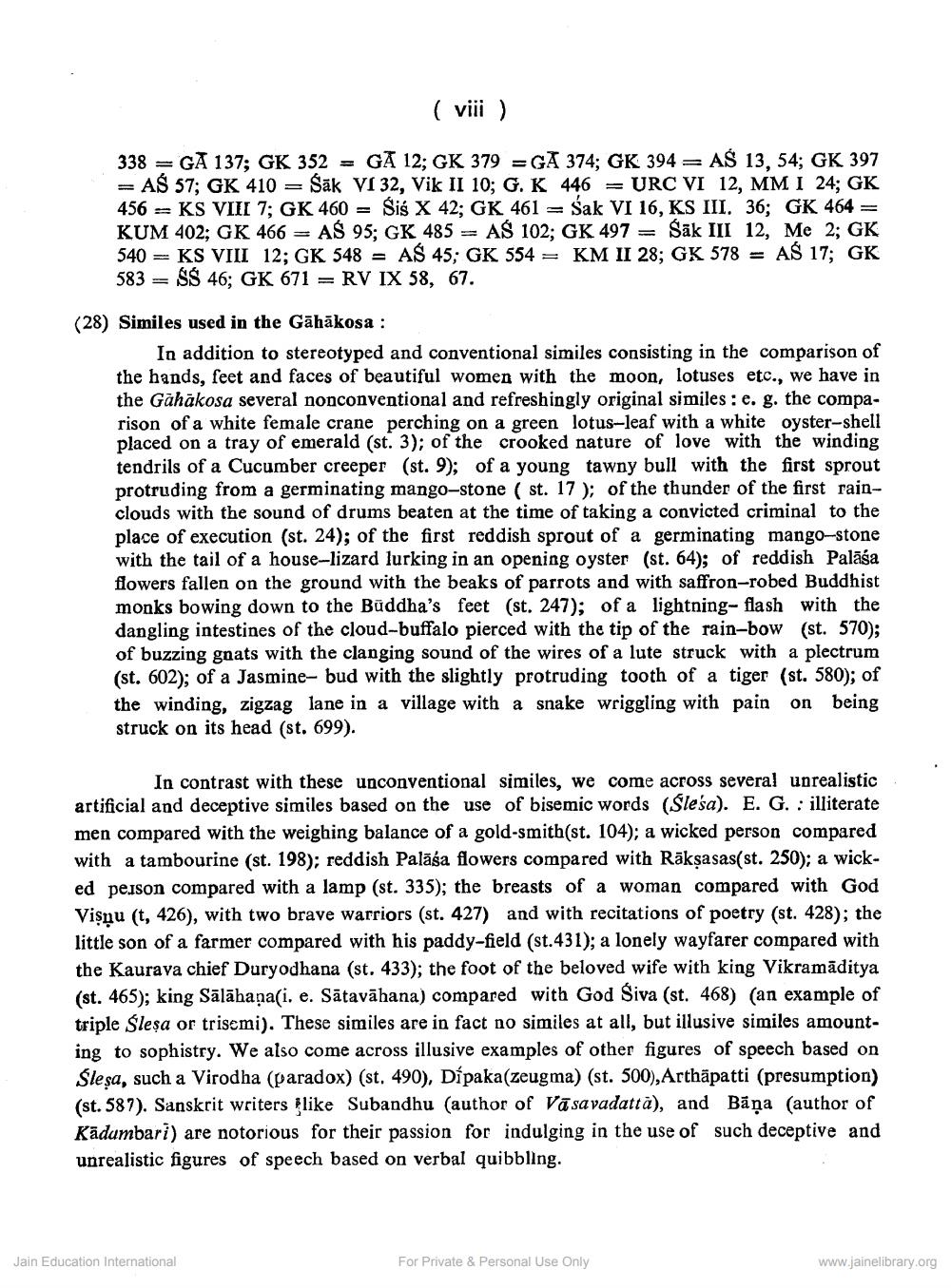________________
(viii)
338 = GÅ 137; GK 352 = GA 12; GK 379 = GA 374; GK 394 = A$ 13, 54; GK 397 = AS 57; GK 410 = Sāk Ví 32, Vik II 10; G. K 446 = URC VI 12, MM I 24; GK 456 = KS VIII 7; GK 460 = Siś X 42; GK 461 = Sak VI 16, KS III. 36; GK 464 = KUM 402; GK 466 = AŚ 95; GK 485 = AŚ 102; GK 497 = Sāk III 12, Me 2; GK 540 = KS VIII 12; GK 548 = A$ 45; GK 554 = KM II 28; GK 578 = AŚ 17; GK 583 = SS 46; GK 671 = RV IX 58, 67.
(28) Similes used in the Gähäkosa :
In addition to stereotyped and conventional similes consisting in the comparison of the hands, feet and faces of beautiful women with the moon, lotuses etc., we have in the Gahakosa several nonconventional and refreshingly original similes: e. g. the comparison of a white female crane perching on a green lotus-leaf with a white Oyster-shell placed on a tray of emerald (st. 3); of the crooked nature of love with the winding tendrils of a Cucumber creeper (st. 9); of a young tawny bull with the first sprout protruding from a germinating mango-stone (st. 17 ); of the thunder of the first rainclouds with the sound of drums beaten at the time of taking a convicted criminal to the place of execution (st. 24); of the first reddish sprout of a germinating mango-stone with the tail of a house-lizard lurking in an opening oyster (st. 64); of reddish Palāśa flowers fallen on the ground with the beaks of parrots and with saffron-robed Buddhist monks bowing down to the Buddha's feet (st. 247); of a lightning-flash with the dangling intestines of the cloud-buffalo pierced with the tip of the rain-bow (st. 570); of buzzing gnats with the clanging sound of the wires of a lute struck with a plectrum (st. 602); of a Jasmine- bud with the slightly protruding tooth of a tiger (st. 580); of the winding, zigzag lane in a village with a snake wriggling with pain on being struck on its head (st. 699).
In contrast with these unconventional similes, we come across several unrealistic artificial and deceptive similes based on the use of bisemic words (Ślesa). E. G. : illiterate men compared with the weighing balance of a gold-smith(st. 104); a wicked person compared with a tambourine (st. 198); reddish Palāśa flowers compared with Rāksasas(st. 250); a wicked peison compared with a lamp (st. 335); the breasts of a woman compared with God Vişnu (t, 426), with two brave warriors (st. 427) and with recitations of poetry (st. 428); the little son of a farmer compared with his paddy-field (st.431); a lonely wayfarer compared with the Kaurava chief Duryodhana (st. 433); the foot of the beloved wife with king Vikramāditya (st. 465); king Sālāhaņa(i, e. Sātavāhana) compared with God Siva (st. 468) (an example of triple Sleşa or trisemi). These similes are in fact no similes at all, but illusive similes amounting to sophistry. We also come across illusive examples of other figures of speech based on Ślesa, such a Virodha (paradox) (st. 490), Dípaka(zeugma) (st. 500), Arthāpatti (presumption) (st. 587). Sanskrit writers like Subandhu (author of Vā savadatta), and Bāņa (author of Kādumbari) are notorious for their passion for indulging in the use of such deceptive and unrealistic figures of speech based on verbal quibbling.
Jain Education International
For Private & Personal Use Only
www.jainelibrary.org




